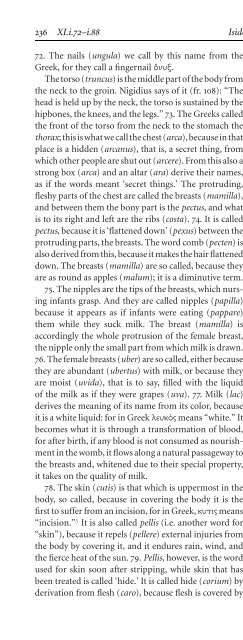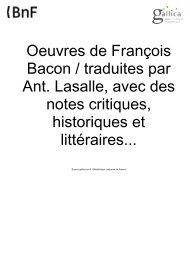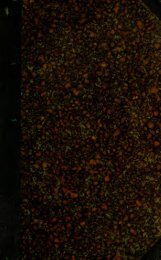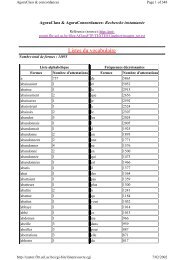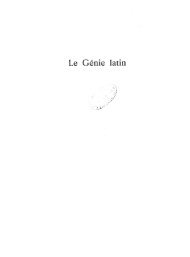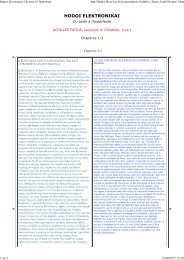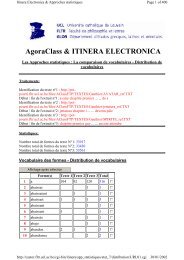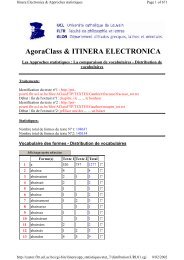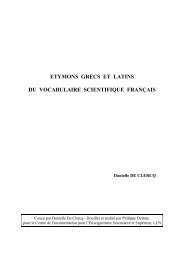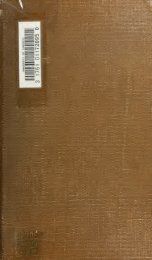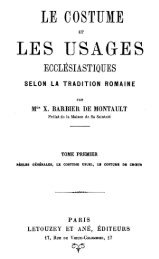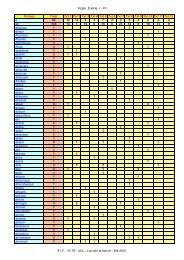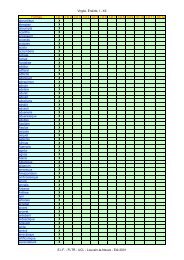The Etymologies of Isidore of Seville - Pot-pourri
The Etymologies of Isidore of Seville - Pot-pourri
The Etymologies of Isidore of Seville - Pot-pourri
You also want an ePaper? Increase the reach of your titles
YUMPU automatically turns print PDFs into web optimized ePapers that Google loves.
236 XI.i.72–i.88 <strong>Isidore</strong> <strong>of</strong> <strong>Seville</strong><br />
72. <strong>The</strong>nails(ungula) wecall by this name from the<br />
Greek, for they call a fingernail .<br />
<strong>The</strong> torso (truncus)isthemiddle part <strong>of</strong> the body from<br />
the neck to the groin. Nigidius says <strong>of</strong> it(fr. 108): “<strong>The</strong><br />
head is held up by the neck, the torso is sustained by the<br />
hipbones, the knees, and the legs.” 73.<strong>The</strong>Greeks called<br />
the front <strong>of</strong> the torso from the neck to the stomach the<br />
thorax; this is what we call the chest (arca), because in that<br />
place is a hidden (arcanus), that is, a secret thing, from<br />
which other people are shut out (arcere). From this also a<br />
strong box (arca) andanaltar (ara) derive their names,<br />
as if the words meant ‘secret things.’ <strong>The</strong> protruding,<br />
fleshy parts <strong>of</strong> the chest are called the breasts (mamilla),<br />
and between them the bony part is the pectus, and what<br />
is to its right and left are the ribs (costa). 74. Itiscalled<br />
pectus,because it is ‘flattened down’ (pexus)betweenthe<br />
protruding parts, the breasts. <strong>The</strong> word comb (pecten)is<br />
also derived from this, because it makes the hair flattened<br />
down. <strong>The</strong> breasts (mamilla)are so called, because they<br />
are as round as apples (malum); it is a diminutive term.<br />
75.<strong>The</strong> nipples are the tips <strong>of</strong> the breasts, which nursing<br />
infants grasp. And they are called nipples (papilla)<br />
because it appears as if infants were eating (pappare)<br />
them while they suck milk. <strong>The</strong> breast (mamilla) is<br />
accordingly the whole protrusion <strong>of</strong> the female breast,<br />
the nipple only the small part from which milk is drawn.<br />
76.<strong>The</strong> female breasts (uber)are so called, either because<br />
they are abundant (ubertus) with milk, or because they<br />
are moist (uvida), that is to say, filled with the liquid<br />
<strong>of</strong> the milk as iftheyweregrapes(uva). 77. Milk(lac)<br />
derives the meaning <strong>of</strong> its name from its color, because<br />
it is a white liquid: for in Greek means “white.” It<br />
becomes what it is through a transformation <strong>of</strong> blood,<br />
for after birth, if any blood is not consumed as nourishment<br />
in the womb, it flows along a natural passageway to<br />
the breasts and, whitened due to their special property,<br />
it takes on the quality <strong>of</strong> milk.<br />
78. <strong>The</strong>skin (cutis) isthat which is uppermost in the<br />
body, so called, because in covering the body it is the<br />
first to suffer from an incision, for in Greek, means<br />
“incision.” 3 It is also called pellis (i.e. another word for<br />
“skin”), because it repels (pellere)external injuries from<br />
the body by covering it, and it endures rain, wind, and<br />
the fierce heat <strong>of</strong> the sun. 79. Pellis,however,istheword<br />
used for skin soon after stripping, while skin that has<br />
been treated is called ‘hide.’ It is called hide (corium)by<br />
derivation from flesh (caro), because flesh is covered by<br />
it, but properly speaking the word is used in reference<br />
to brute beasts. 80. <strong>The</strong>wordforthepores(porus) <strong>of</strong><br />
the body is Greek – these in Latin properly are called<br />
air-passages (spiramentum), because through them the<br />
enlivening breath (spiritus)issupplied from the outside.<br />
81. Arvina is the fat that adheres to the skin. A ‘fleshy part’<br />
(pulpa) isflesh without fat, so called because it pulsates<br />
(palpitare): for it <strong>of</strong>ten quivers. Many also call it viscus<br />
(“flesh”; cf. the homophone viscus,“birdlime”) because<br />
it is sticky.<br />
82. <strong>The</strong>limbs (membrum) aretheparts <strong>of</strong> the body.<br />
<strong>The</strong> joints (artus), with which the limbs are connected,<br />
are so called from ‘drawing together’ (artare). 83. <strong>The</strong><br />
sinews (nervus) aresocalled through a derivation from<br />
the Greek, as they call a sinew .Others believe that<br />
‘sinews’ comes from Latin, because the connections <strong>of</strong><br />
the joints attach (inhaerere) tothemeachinturn.But<br />
this much is certain: the sinews constitute the greatest<br />
part <strong>of</strong> the substance <strong>of</strong> strength, for the thicker they are,<br />
the more they are disposed to augment strength. 84.<strong>The</strong><br />
joints (artus)are so called because, being bound to each<br />
other by the tendons, they are ‘drawn together’ (artare),<br />
that is, they are bound tight. <strong>The</strong> diminutive form <strong>of</strong><br />
artus is articulus; weuse the word artus in reference to<br />
main limbs, like the arms, but the word articulus in reference<br />
to minor limbs like the fingers. 85. <strong>The</strong>heads <strong>of</strong><br />
the bones are called compago,because they hold together<br />
through being connected (compingere, ppl. compactus)<br />
with sinews as if with a kind <strong>of</strong> glue.<br />
86. <strong>The</strong>bones (os, gen.ossis) arethefirm parts <strong>of</strong><br />
the body. <strong>The</strong>y support all postures <strong>of</strong> the body and<br />
give it strength. <strong>The</strong> bones are so called from burning<br />
(urere,ppl. ustus), because they would be cremated by the<br />
ancients; or, as others believe, from mouth (os), because<br />
there they are visible, while in the rest <strong>of</strong> the body they<br />
are hidden, covered by skin and flesh. 87.‘Bonemarrow’<br />
(medulla) issocalled, because it moistens (madefacere)<br />
the bones, for it supplies fluid and strengthens them.<br />
<strong>The</strong> vertibulum is the end point <strong>of</strong> a bone, rounded in<br />
athicker knot; it is so called because it is turned (vertere)<br />
when the limb is bent. 88. Cartilage consists <strong>of</strong> s<strong>of</strong>t<br />
bones without bone marrow, the kind that the ear, the<br />
septum, and the ends <strong>of</strong> the ribs have, or also the covering<br />
<strong>of</strong> bones, which moves. And it is called cartilage<br />
3 AGreekword is not otherwise known. Latin cutis is in fact<br />
cognate with Greek , “skin, hide”; , “hollow, vessel.”


